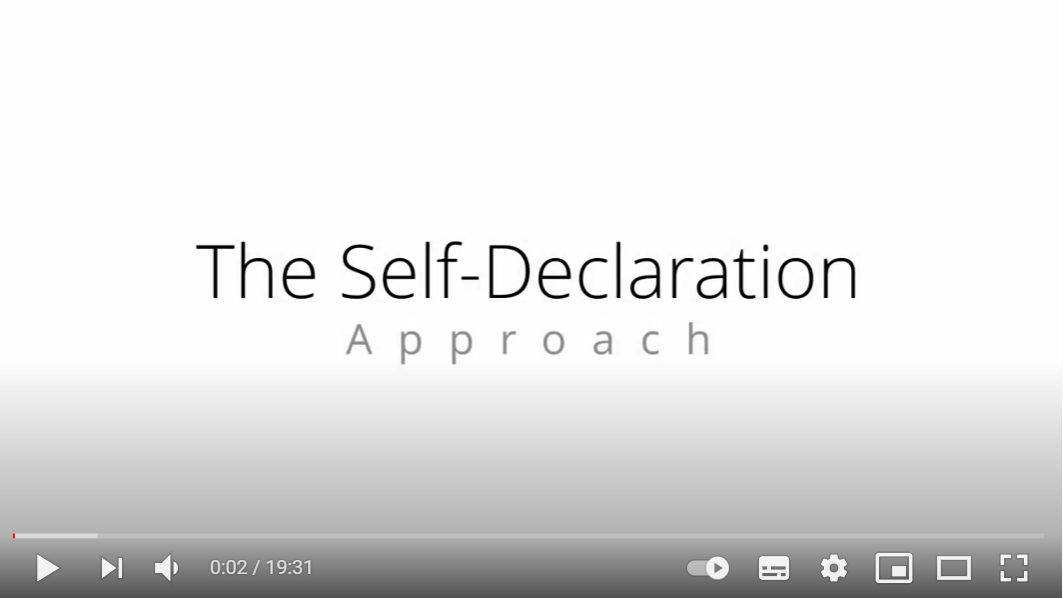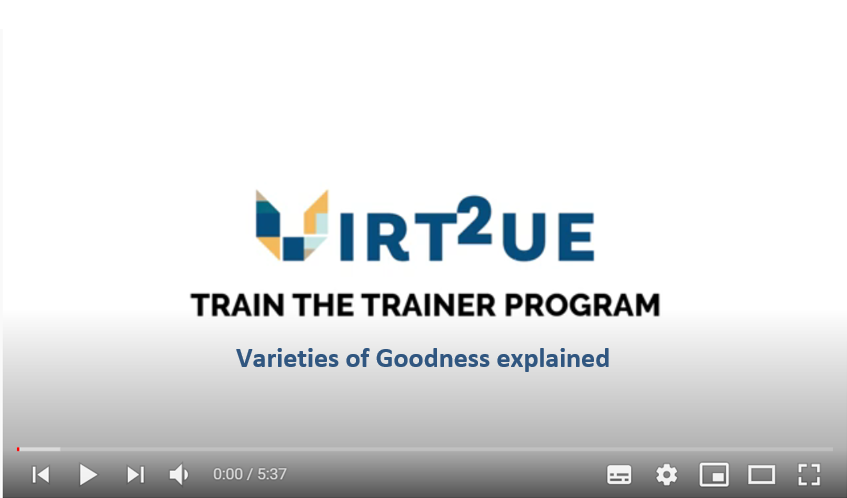Self Declaration Approach - a Reflection on the Varieties of Goodness in Research
Self Declaration Approach - a Reflection on the Varieties of Goodness in Research
You need to have read the exercise's instructions before experiencing the exercise.
Moreover, you need to be acquainted with:
1) The concept of virtue and its importance for RI;
2) The content of the European Code of Conduct for Research Integrity.
You need to have a background in research (i.e. be employed as researchers) or be a trainer/educator/teacher who has had experience in research in the past.What is this about?
Why is this important?
Practical Tips
1. Prior to the meeting, your trainer may require you to watch this video on the Self-declaration Approach and the typologies of goodness.
2. During the training session, share with the group your inputs in the self-declaration sheets on the types of goodness. Explain why you think your example exemplifies a certain type of goodness. Allow your group mates to ask questions.
3. For each type of goodness, discuss with your group what can happen if a type of goodness is not present.
4. Are there forms or types of goodness that are less relevant for research integrity?
4. Are virtues necessary to achieve each type of goodness?Preparation
A few weeks before the session, you will be asked by your trainer to prepare for the session. For this you will need to fill out the self-declaration sheet (which will be sent to you by your trainer) and send it to the trainer at least a week before the training session. You may download samples of the self-declaration sheets HERE and HERE. The self-declaration sheet allows you to reflect on your intuitions on goodness and will be used by the trainer to include your intuitions in the discussion during the session.
Watch the videos to have an impression of this VIRT2UE Train-the-Trainer program.


Experiencing the exercise
During the session, you are guided by a trainer who facilitates a group reflection about the concept of goodness. For this purpose, you will:
- Learn about the varieties of goodness in research;
- Reflect on your self declaration sheet in small groups (please look at practical tips for a list of questions you can use to structure your reflection);
- Reflect on how the different types of goodness may be categorized;
- Reflect on the content of the European Code of Conduct for Research Integrity (ECoC) by identifying how the types of goodness are exemplified in the code.
The session will be based on the input you and the other participants gave in the self-reflection sheet you have filled in.
For an overview of the steps in this exercise please look at the instructions for trainers.Remarks
List of contributors:
Jan Helge Solbakk, Rosemarie Bernabe, Panagiotis Kavouras, Signe Mezinska, Volkan Kavas, Franca Marino.
This training has been developed by the VIRT2UE project, which has received funding form the European Union’s H2020 research programme under grant agreement N 741782.What is this about?
The exercise is designed to stimulate reflection on research integrity in a classroom setting by using the question “what is goodness and how may it be categorized” as a springboard. The focus of the exercise is to discuss the types of goodness and to reflect on the concept of goodness in research. This exercise is inspired by a broader and flexible approach, The Self-Declaration Approach (SDA)[1], which makes use of participants’ responses to a self-declaration sheets to structure reflection on a specific research integrity (RI) topic. Including the participants’ intuitions in the discussion is the hallmark of this approach. This format is flexible in terms of its applicability and adaptability to different RI topics and different audiences.
- ↑ Solbakk, JH. (2015). What is it to do good medical ethics? One the concepts of “good” and “goodness” in medical ethics. J Med Ethics (41): 12-16
Why is this important?
Distribute assignments
A few weeks before the session, get in contact with the participants in the session and ask them to do the following:
- to prepare by filling out the self-declaration sheet. You may download samples of this sheet HERE and HERE. Adapt the sheets as you see fit.
- If you wish to not discuss the typologies of goodness extensively during the session, make the participants watch this video on the Self-Declaration Approach and the Typologies of Goodness.
Set a deadline for the assignment and ask participants to send you their self-declaration sheet at least one week before the session.
The self-declaration sheet allows participants to reflect on the types of goodness from their standpoint. This also provides you with content for discussion during the session.
When distributing the assignments be sure to mention that participants should not forget to bring a copy (either print or electronic) of their filled-out self-declaration sheets to the session and to be ready to discuss their responses with the rest of the group.
Protect confidentiality
Remind participants that responses provided in the self declaration sheet will be used for, and only for, class purposes, and that they should only share information that they are comfortable sharing with the class and that would not necessitate mandatory reporting. It is strongly recommended to ask participants to sign a confidentiality agreement.
Prepare for the session
Collect the sheets in due time and familiarize yourself with the responses given by participants. Participant’s input will be useful the content of the session. Prepare a Powerpoint presentation to facilitate the reflection during the session. If you made the participants watch the video on the typologies of goodness, here is a sample powerpoint you can use. If you did not make the participants watch the video, you may use this powerpoint. Revise the presentation as needed.
Introduce the concept of goodness in research
Give a short presentation of the varieties of goodness with a specific focus on goodness in research. The length and depth of presentation will depend on whether you made the participants watch the video.
Foster reflection in subgroups
Divide participants into groups of 3 to 5 and ask them to discuss their inputs in their self-declaration sheets and to relate their inputs to virtues and research integrity .
Provide trainees with the following lists of questions which they can use to stimulate reflection:
1. Share with the group your inputs in the self-declaration sheets on the types of goodness. Explain why you think your example exemplifies a certain type of goodness. Allow your group mates to ask questions.
2. For each typology of goodness, discuss with your group what can happen if a type of goodness is not present.
3. Are there varieties of goodness that are less relevant for research integrity?
4. Are virtues necessary to achieve each typology of goodness?
Give the trainees 20 to 30 minutes to discuss and to decide among themselves who should be the rapporteur.Discuss groups' results and close the session
After reflecting on the self-declaration sheet in small groups, invite participants to go back to the plenary session and ask them to report on their responses to the questions. Note that during the reporting they don’t have to report on each example. Rather, ask them if there were difficulties in providing examples and if there were disagreements. Conclude the session by summarizing the group findings and by going through sections of the European Code Of Conduct For Research Integrity (ECoC) that exemplify the typologies of goodness.
Remarks
List of contributors:
Jan Helge Solbakk, Rosemarie Bernabe, Panagiotis Kavouras, Signe Mezinska, Volkan Kavas, Franca Marino.
This training has been developed by the VIRT2UE project, which has received funding form the European Union’s H2020 research programme under grant agreement N 741782.
